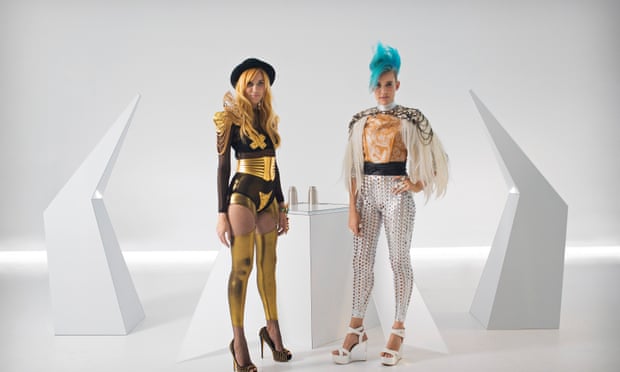Nervo head up a new initiative aimed at encouraging young Australian women to study engineering
With their spiked hair, sparkly eye makeup and heavily embellished costumes, they don’t look like engineers – and that’s exactly the point.
The Melbourne-born electronic dance music duo Nervo – singer-songwriters and twin sisters Miriam and Olivia Nervo – have launched their latest song and video, People Grinnin’. Catchy as the tune is, the clip has a bigger purpose. It’s part of the Made By Me initiative, a national collaboration between eight Australian universities aimed at challenging stereotypes in the engineering industry and encouraging more young women to consider it as a career option.
The futuristic-looking clip begins with the phrase “Everything in the following music video was made by an engineer” and sees a group of female engineers working with touchscreens and high-tech equipment to construct android versions of the twins.
The musicians, who trained as sound engineers, co-wrote the Grammy-nominated song When Love Takes Over with David Guetta and have produced songs for Kylie Minogue, Kesha and Miley Cyrus.
The duo said in a statement they wanted to take part in the initiative because they remembered being the only girls in their engineering course. “We loved the chance to show the world that there is engineering in every aspect of our lives. We’re sound engineers but our whole show is only made possible through expert engineering. From the makeup we wear, to the lights and the stage we perform on. Engineering makes it all possible, including the music that we make.”
Australia is currently suffering from a “dramatic” shortage of engineers. The general manager of Engineering Australia, Greg Ewing, says 54% of engineers currently employed in Australia are born overseas. He says more than 20,000 entry-level engineering jobs come up each year but there are fewer than 10,000 graduates to fill them.
However, the industry’s gender balance is particularly jarring, with only 13% of positions filled by women. This is despite the fact that female engineering graduates enjoy a significant pay advantage. According to the 2014 Graduate Salaries Report, the median starting salaries of female bachelor degree graduates in first full-time employment is $65,000, with male graduates receiving just $60,000. Overall engineering is one of the highest-paid industries for Australian graduates, coming in third after dentistry and optometry, for median salary starting at $62,000.
Ewing believes this pay advantage comes down to engineering companies recognising the need for a diverse workforce and being willing to pay a premium for female employees. “Engineers solve problems, so if you want to get the best solution to a problem, you need to get the best mix of minds looking at that problem … If you bring everybody that is the same to the table, you’ll get the same old answers.”
Varuni Fernando graduated from an electrical engineering course at the University of New South Wales in 2014 and now works at the biomedical company Resmed.
Looking back, she estimates only 10% of the students on her degree course were female. After excelling at high school maths and physics, she choose to study engineering because she wanted to do something that made a difference. “I like the idea that the things that I work on help improve people’s health outcomes.”
She says many of her fellow female high school students choose medicine for the same reason but they were unaware of the career possibilities with an engineering degree.
This lack of understanding of the real life applications of engineering is what discourages more women from entering the industry, she says. When she explains the opportunities to high school students about the industry, she says they get excited. “When you show them pictures of engineers giving water to a very poor community or giving someone who didn’t have sight the ability to see something again, that really inspires them.”
However, she added that, while encouraging steps were being taken to recruit more female engineering students, the industry also needed to figure out how to retain those women who were currently employed. “There are so many women who leave engineering for all sorts of reasons but a lot stems from the fact that there just aren’t enough of us in it to support each other.”
Recent US research found that, during internships and other work opportunities, female engineers were not offered as many opportunities to work on the more challenging problems as men and instead were assigned routine tasks or managerial duties. “It turns out gender makes a big difference,” said MIT researcher Susan Silbey.
Like the other science, technology, engineering and mathematics industries, there is a significant push recently to increase the number of women in engineering, not least because these industries will be increasingly important in the evolving future workplace.
In January the CSIRO report Tomorrow’s Digitally Enhanced Workplace, which looked at the employment trends in Australia for the next two decades, found that “Science, technology, engineering and mathematics (Stem) knowledge is associated with 75% of the fastest growing occupations, innovations and wage premiums.” However, the report also found that “current trends demonstrate falling interest in Stem among Australian youth”.
Ewing agreed steps must be taken to encourage engineers of both genders, as they will have an increasingly important role to play in the not-too-distant future.
“If we, as a society and a community and an economy, are going to grow in a sustainable way and in a way that we make the best use of what’s available to us … it will take engineers to do that.”
Published in Guardian Australia on 19 July 2016 as Music with a message: engineering industry tackles shortage of female students



